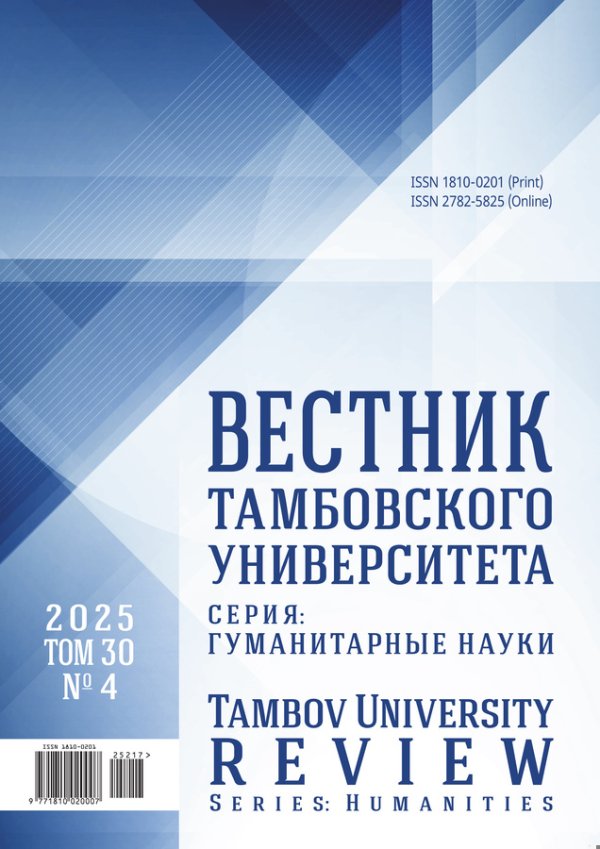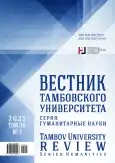Функциональные возможности чат-бота ChatGPT в иноязычной преподавательской деятельности
- Авторы: Черкасова Е.А.1
-
Учреждения:
- Национальный исследовательский ядерный университет «МИФИ»
- Выпуск: Том 30, № 1 (2025)
- Страницы: 84-93
- Раздел: ТЕОРИЯ И МЕТОДИКА ОБУЧЕНИЯ ИНОСТРАННОМУ ЯЗЫКУ
- URL: https://ogarev-online.ru/1810-0201/article/view/297480
- DOI: https://doi.org/10.20310/1810-0201-2025-30-1-84-93
- ID: 297480
Цитировать
Полный текст
Аннотация
Актуальность. Искусственный интеллект стал незаменимый инструментом в различных сферах, предлагая новые инновационные решения: создание тестов, предоставление справочной информации, редактирование видеоматериалов, генерация изображений. Существует множество приложений, функционирующих на основе технологий ИИ, однако, одним из самых прогрессивных является чат-бот ChatGPT, который находит свое применение в образовательной среде, выступая в роли эффективного помощника не только для обучающихся, но и для преподавателей благодаря генерируемой обратной связи. Цель исследования – определение функциональных возможностей чат-бота в процессе преподавания иностранного языка.
Материалы и методы. Реализованы теоретический и эмпирический методы: обзор, анализ и синтез научной литературы по теме исследования, а также экспериментально-практическое взаимодействие с приложением ChatGPT.
Результаты исследования. Были выявлены следующие функции чат-бота ChatGPT в рамках иноязычной преподавательской деятельности: организация и планирование учебного процесса; генерация учебных материалов в соответствии с конкретными образовательными целями и потребностями; предоставление вариативной теоретической информации; оптимизация проверки и оценивания письменных заданий.
Выводы. Благодаря выявленному полезному функционалу, который охватывает разнообразные аспекты преподавательской деятельности, чат-бот ChatGPT может стать вспомогательным ресурсом педагога, значительно повышая эффективность и оперативность, а также качество образовательного процесса.
Об авторах
Е. А. Черкасова
Национальный исследовательский ядерный университет «МИФИ»
Автор, ответственный за переписку.
Email: tomchuk.bel@yandex.ru
ORCID iD: 0009-0001-3517-8074
кандидат педагогических наук, преподаватель кафедры иностранных языков института общей профессиональной подготовки
Россия, 115409, Российская Федерация, г. Москва, Каширское ш., 31Список литературы
- Казанцев Т. Искусственный интеллект и машинное обучение. Основы программирования на Python. Мо-сква, 2020. 163 с.
- Лавриненко И.Ю. Использование чат-ботов GPT в процессе обучения английскому языку в неязыковом вузе: теоретический аспект // Вестник Сибирского института бизнеса и информационных технологий. 2023. Т. 12. № 2. С. 18-25. https://doi.org/10.24412/2225-8264-2023-2-18-25, https://elibrary.ru/uiazuw
- Сысоев П.В. Искусственный интеллект в образовании: осведомленность, готовность и практика примене-ния преподавателями высшей школы технологий искусственного интеллекта в профессиональной деятельности // Высшее образование в России. 2023. Т. 32. № 10. С. 9-33. https://doi.org/10.31992/0869-3617-2023-32-10-9-33, https://elibrary.ru/tzytkm
- Сысоев П.В., Филатов Е.М. Методика обучения студентов написанию творческих работ на основе оце-ночной обратной связи от искусственного интеллекта // Перспективы науки и образования. 2024. № 1 (67). С. 115-135. https://doi.org/10.32744/pse.2024.1.6, https://elibrary.ru/tmstly
- Сысоев П.В., Филатов Е.М., Сорокин Д.О. Обратная связь в обучении иностранному языку: от информа-ционных технологий к искусственному интеллекту // Язык и культура. 2024. № 65. С. 242-261. https://doi.org/10.17223/19996195/65/11, https://elibrary.ru/plzyov
- Плохотнюк О.С. Особенности разработки вариативных тестовых заданий с использованием чат-бота с искусственным интеллектом ChatGPT в обучении будущих педагогов иностранному языку // Вестник МГПУ. Серия: Информатика и информатизация образования. 2023. № 3 (65). С. 107-115. https://doi.org/10.25688/2072-9014.2023.65.3.10, https://elibrary.ru/akjnyd
- Сысоев П.В., Филатов Е.М. Чат-боты в обучении иностранному языку: преимущества и спорные вопросы // Вестник Тамбовского университета. Серия: Гуманитарные науки. 2023. Т. 28. № 1. С. 66-71. https://doi.org/10.20310/1810-0201-2023-28-1-66-72, https://elibrary.ru/pxgztj
- Бермус А.Г. Преимущества и риски использования ChatGPT в системе высшего образования: теоретиче-ский обзор // Педагогика. Вопросы теории и практики. 2024. Т. 9. № 8. С. 776-787. https://doi.org/10.30853/ped20240099, https://elibrary.ru/dpyudu
- Богачевский В.М., Куприна Т.В. Использование ChatGPT в обучении грамматике английского языка // Бизнес. Образование. Право. 2024. № 2 (67). С. 306-313. https://doi.org/10.25683/VOLBI.2024.67.939, https://elibrary.ru/tzuadf
- Черкасова Е.А. Комплекс команд по выполнению упражнений и заданий в рамках обучения грамматике английского языка студентов технических вузов посредством чат-бота ChatGPT // Филологические нау-ки. Вопросы теории и практики. 2024. Т. 17. № 5. С. 1633-1639. https://doi.org/10.30853/phil20240236, https://elibrary.ru/ggpabp
- Черкасова Е.А. Применение искусственного интеллекта в обучении английскому языку в неязыковом вузе: анализ чата GPT в контексте оценки письменных работ // Бизнес. Образование. Право. 2023. № 4 (65). С. 437-442. https://doi.org/10.25683/VOLBI.2023.65.837, https://elibrary.ru/amnqli
- Koraishi O. Teaching English in the age of AI: embracing chatgpt to optimize EFL materials and assessment // Language Education & Technology. 2023. Vol. 3. Issue 1. Р. 55-72.
- Hwang W.Y., Nurtantyana R., Purba S.W.D., Hariyanti U., Indrihapsari Yu., Surjono H.D. AI and recognition technologies to facilitate English as foreign language writing for supporting personalization and contextualization in authentic contexts // Journal of Educational Computing Research. 2023. Vol. 61. Issue 5. Р. 1008-1035. https://doi.org/10.1177/07356331221137253
- Сысоев П.В., Филатов Е.М., Евстигнеев М.Н., Поляков О.Г., Евстигнеева И.А., Сорокин Д.О. Матрица инструментов искусственного интеллекта в лингвометодической подготовке будущих учителей ино-странного языка // Вестник Тамбовского университета. Серия: Гуманитарные науки. 2024. Т. 29. № 3. С. 559-588. https://doi.org/10.20310/1810-0201-2024-29-3-559-588, https://elibrary.ru/jazkme
- Сысоев П.В., Филатов Е.М. СhatGPT в исследовательской работе студентов: запрещать или обучать? // Вестник Тамбовского университета. Серия: Гуманитарные науки. 2023. Т. 28. № 2. С. 276-301. https://doi.org/10.20310/1810-0201-2023-28-2-276-301, https://elibrary.ru/sphxkz
- Евстигнеев М.Н. Планирование учебного занятия по иностранному языку с помощью технологий гене-ративного искусственного интеллекта // Вестник Тамбовского университета. Серия: Гуманитарные нау-ки. 2024. Т. 29. № 3. С. 617-634. https://doi.org/10.20310/1810-0201-2024-29-3-617-634, https://elibrary.ru/ahylwe
- Сысоев П.В. Дидактические свойства и методические функции нейросетей // Перспективы науки и образования. 2024. № 6 (72). С. 672-690. https://doi.org/10.32744/pse.2024.6.42, https://elibrary.ru/ggnyfw
- Schmidt T., Strasser T. Artificial Intelligence in foreign language learning and teaching // A CALL for Intelligent Practice. 2022. Vol. 33. Issue 1. Р. 165-184. https://doi.org/10.33675/ANGL/2022/1/14
- Хеннер Е.К. Информационные технологии в образовании. Пермь, 2022. 110 с.
- Даггэн С. Искусственный интеллект в образовании: изменение темпов обучения // Аналитическая запис-ка ИИТО ЮНЕСКО. Москва, 2020. 44 с.
Дополнительные файлы










